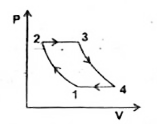Write the expressions for CvandCp of a gas in terms of gas constant R and γ where
γ=Cp/Cv
To derive the expressions for Cv and Cp of a gas in terms of the gas constant R and γ (where γ=CpCv), we can follow these steps:
Step 1: Understand the relationship between Cp, Cv, and R
We know two important relationships:
1. The ratio of specific heats:
γ=CpCv
2. The difference between specific heats at constant pressure and constant volume is equal to the gas constant:
Cp−Cv=R
Step 2: Express Cp in terms of Cv
From the first relationship, we can express Cp in terms of Cv:
Cp=γCv
Step 3: Substitute Cp into the second relationship
Now, substitute Cp from Step 2 into the second relationship:
γCv−Cv=R
Step 4: Factor out Cv
This simplifies to:
Cv(γ−1)=R
Step 5: Solve for Cv
Now, we can solve for Cv:
Cv=Rγ−1
Step 6: Substitute Cv back to find Cp
Now that we have Cv, we can find Cp using the expression from Step 2:
Cp=γCv=γ(Rγ−1)
Step 7: Simplify the expression for Cp
This gives us:
Cp=γRγ−1
Final Expressions
Thus, the final expressions for the specific heats are:
Cv=Rγ−1
Cp=γRγ−1
We know two important relationships:
1. The ratio of specific heats:
γ=CpCv
2. The difference between specific heats at constant pressure and constant volume is equal to the gas constant:
Cp−Cv=R
From the first relationship, we can express Cp in terms of Cv:
Cp=γCv
Now, substitute Cp from Step 2 into the second relationship:
γCv−Cv=R
This simplifies to:
Cv(γ−1)=R
Now, we can solve for Cv:
Cv=Rγ−1
Now that we have Cv, we can find Cp using the expression from Step 2:
Cp=γCv=γ(Rγ−1)
This gives us:
Cp=γRγ−1
Thus, the final expressions for the specific heats are:
Cv=Rγ−1
Cp=γRγ−1
Topper's Solved these Questions
- THERMODYNAMICS Book:CBSE COMPLEMENTARY MATERIALChapter:THERMODYNAMICS Exercise:SHORT ANSWER TYPE QUESTIONS (3 MARKS)
Explore 10 Videos
- THERMODYNAMICS Book:CBSE COMPLEMENTARY MATERIALChapter:THERMODYNAMICS Exercise:LONG ANSWER TYPE QUESTIONS (5 MARKS)
Explore 1 Video
- THERMODYNAMICS Book:CBSE COMPLEMENTARY MATERIALChapter:THERMODYNAMICS Exercise:MULTIPLE CHOICE QUESTIONS (MCQs)
Explore 20 Videos
- ROTATIONAL MOTION Book:CBSE COMPLEMENTARY MATERIALChapter:ROTATIONAL MOTION Exercise:MULTIPLE CHOICE QUESTIONS
Explore 20 Videos
- WORK, ENERGY AND POWERBook:CBSE COMPLEMENTARY MATERIALChapter:WORK, ENERGY AND POWERExercise:MCQ
Explore 20 Videos
Similar Questions
A gas undergoes cyclic process 1-2-3-4-1 in which 1-2 and 3-4 are adiabatic process 2-3 and 4-1 are isobaric process. If P2P1=k then what will be the efficiency of cycle in terms of k and γ where γ=Cp/Cv.

View SolutionWhich of the following is true in the case of an adiabatic process, where γ=CpCv?
View Solution
Knowledge Check
if R is the molar gas constant and γ=CP/CV, then CV is equal to
AR/γBγRC2Rγ−1DRγ−1If R is the molar gas constant and γ=CP/CV, then Cp is equal to
AR/γBγRC2Rγ−1DRγγ−1For adiabatic processes (γ=CpCv)
APγV=constantBTγV=constantCTVγ−1=constantDTVγ=constant
105 calories of heat is required to raise the temperature of 3 moles of an ideaol gas at constant pressure from30∘C to 35∘C. The amount of heat required in calories to raise the temperature of the gas though the range (60∘C to 65∘C) at constant volume is (γ=CpCv=1.4)
View SolutionIn previous, Find the value of γ=CP/Cv:
View SolutionThe molar specific heat of an ideal gas at constant pressure and constant volume is Cp and Cv respectively. If R is the universal gas constant and the ratio of Cp to Cv is γ, then Cv.
View SolutionDuring an adiabatic process , the pressure p of a fixed mass of an ideal gas change by Δpand its volume V change by ΔV . If γ=Cp/Cv then ΔV/V is given by
View SolutionThe internal energy of a gas is given by U = 3 pV. It expands from V0 to 2V0 against a constant pressure p0.
What is the value of γ(=CP/CV) for the given gas?
View Solution